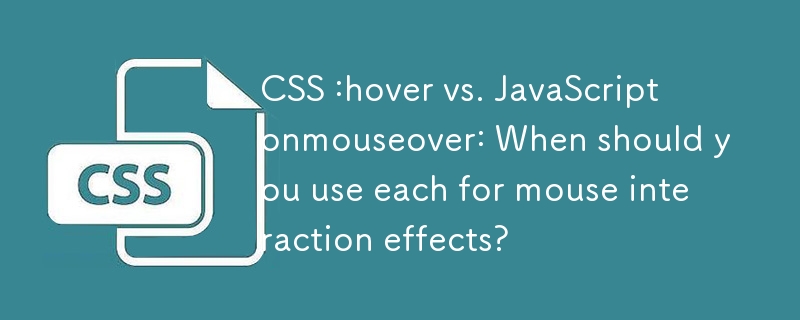 Web Front-end
Web Front-end
 CSS Tutorial
CSS Tutorial
 CSS :hover vs. JavaScript onmouseover: When should you use each for mouse interaction effects?
CSS :hover vs. JavaScript onmouseover: When should you use each for mouse interaction effects?
CSS :hover vs. JavaScript onmouseover: When should you use each for mouse interaction effects?

CSS hover vs. JavaScript mouseover: Which approach should you use?
When controlling the appearance of HTML elements based on mouse interactions, one often faces the choice between using CSS's :hover pseudo-class and JavaScript's onmouseover event. This article delves into the advantages and disadvantages of each approach to help you make an informed decision.
CSS hover approach
The CSS :hover pseudo-class allows you to specify styles that are applied when the mouse cursor hovers over an element. This is a straightforward and widely supported approach, making it an appealing choice for many scenarios.
1 2 |
|
JavaScript mouseover approach
The JavaScript onmouseover event allows you to execute JavaScript code when the mouse cursor hovers over an element. This approach provides greater flexibility and control over the element's appearance.
1 2 3 |
|
Advantages and disadvantages
- Browser support: CSS :hover is widely supported across all modern browsers. However, older versions of Internet Explorer (IE6) only support :hover on anchor tags ( elements).
- Performance: Generally, CSS styles are processed more efficiently by the browser than JavaScript code. Therefore, the CSS approach is faster, especially for animations and effects that involve frequent updates.
- Flexibility: JavaScript provides greater flexibility, allowing you to execute custom logic, perform calculations, and respond to user input. You can create complex and dynamic interactions that would be difficult to achieve with CSS alone.
Recommendation
For simple hover effects where cross-browser compatibility is paramount, CSS :hover is recommended. However, if you need advanced features, require dynamic behavior, or need to support older versions of IE, JavaScript onmouseover is a suitable alternative.
Note: The jQuery library can simplify JavaScript hover implementations, as illustrated in the example provided in the answer:
1 2 3 4 5 |
|
The above is the detailed content of CSS :hover vs. JavaScript onmouseover: When should you use each for mouse interaction effects?. For more information, please follow other related articles on the PHP Chinese website!

Hot AI Tools

Undresser.AI Undress
AI-powered app for creating realistic nude photos

AI Clothes Remover
Online AI tool for removing clothes from photos.

Undress AI Tool
Undress images for free

Clothoff.io
AI clothes remover

Video Face Swap
Swap faces in any video effortlessly with our completely free AI face swap tool!

Hot Article

Hot Tools

Notepad++7.3.1
Easy-to-use and free code editor

SublimeText3 Chinese version
Chinese version, very easy to use

Zend Studio 13.0.1
Powerful PHP integrated development environment

Dreamweaver CS6
Visual web development tools

SublimeText3 Mac version
God-level code editing software (SublimeText3)

Hot Topics
 Vue 3
Apr 02, 2025 pm 06:32 PM
Vue 3
Apr 02, 2025 pm 06:32 PM
It's out! Congrats to the Vue team for getting it done, I know it was a massive effort and a long time coming. All new docs, as well.
 Can you get valid CSS property values from the browser?
Apr 02, 2025 pm 06:17 PM
Can you get valid CSS property values from the browser?
Apr 02, 2025 pm 06:17 PM
I had someone write in with this very legit question. Lea just blogged about how you can get valid CSS properties themselves from the browser. That's like this.
 A bit on ci/cd
Apr 02, 2025 pm 06:21 PM
A bit on ci/cd
Apr 02, 2025 pm 06:21 PM
I'd say "website" fits better than "mobile app" but I like this framing from Max Lynch:
 Using Markdown and Localization in the WordPress Block Editor
Apr 02, 2025 am 04:27 AM
Using Markdown and Localization in the WordPress Block Editor
Apr 02, 2025 am 04:27 AM
If we need to show documentation to the user directly in the WordPress editor, what is the best way to do it?
 Stacked Cards with Sticky Positioning and a Dash of Sass
Apr 03, 2025 am 10:30 AM
Stacked Cards with Sticky Positioning and a Dash of Sass
Apr 03, 2025 am 10:30 AM
The other day, I spotted this particularly lovely bit from Corey Ginnivan’s website where a collection of cards stack on top of one another as you scroll.
 Comparing Browsers for Responsive Design
Apr 02, 2025 pm 06:25 PM
Comparing Browsers for Responsive Design
Apr 02, 2025 pm 06:25 PM
There are a number of these desktop apps where the goal is showing your site at different dimensions all at the same time. So you can, for example, be writing
 How to Use CSS Grid for Sticky Headers and Footers
Apr 02, 2025 pm 06:29 PM
How to Use CSS Grid for Sticky Headers and Footers
Apr 02, 2025 pm 06:29 PM
CSS Grid is a collection of properties designed to make layout easier than it’s ever been. Like anything, there's a bit of a learning curve, but Grid is
 Google Fonts Variable Fonts
Apr 09, 2025 am 10:42 AM
Google Fonts Variable Fonts
Apr 09, 2025 am 10:42 AM
I see Google Fonts rolled out a new design (Tweet). Compared to the last big redesign, this feels much more iterative. I can barely tell the difference





